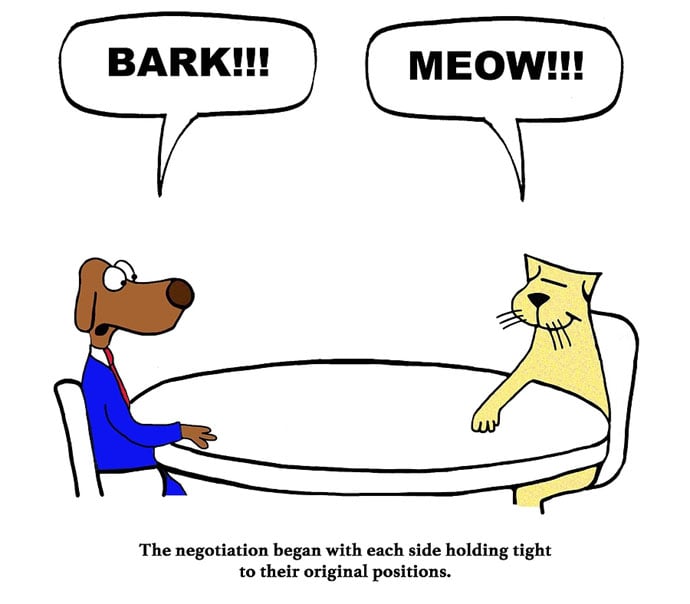Written by Sean McPheat | 

Before we do a deep dive into the world of negotiation skills, let me first ask you a quick question;
Do you remember when you were a kid and you wanted to stay over at a friend’s house?
You may have asked your parents if it was OK to go and that you would be back around lunchtime the following day.
But what if your Mum had said that you hadn’t completed your chores like she’d asked you to before going?
Maybe you would have told her that you would complete them when you return the following day?
Or maybe you would have asked a sibling to help you complete them now?
Whatever it was that you did would have needed persuasion and influencing skills to allow you to have your way, in this case being allowed to stay over at your friends.
You may not have realised it then, but you were learning negotiation skills.
You were vying for position to get something you wanted, knowing that the other interested parties (your parents, siblings and friend) had different agendas they were working from.
This is an example of negotiating on the issue of time. Your parents had the power of veto in this situation because they provided the roof over your head and food on the table.
And it’s also an example of the fact that negotiating isn’t just about money. There are many occasions where we get someone else to move their position on other things in order to attain some form of agreement.
In fact, we negotiate every day. It isn’t just in a sales setting or when we are with clients, online or face-to-face. It may be with our kids, partners, colleagues, friends, suppliers, disgruntled customers, and many others who we encounter day-to-day.

Negotiating comes from the Latin stem of negōtiātiō, which means the doing of business, and is equivalent to negōtiāt(us) in its root form.
Customers used to barter with stall holders in the Roman markets, doing business on all manner of items.
It has come to mean a series of discussions where one party gets the other party to move towards their position in a discussion. If there is no movement, there is no negotiation. Simply put, business isn’t ‘done’.
In a sales setting, you will have a series of ‘positions’ that you will propose, including things like timings, delivery costs, pricing packages, service levels, warranties, etc. Each one will be positioned at a point that makes money for you and also adds value to the customer.
The customer will have different positions and different starting points too.
Your emphasis will be on what you can deliver at the right price for you, where the customer still tries to get you to move closer to their position.
Without this need for ‘movement’, there is no negotiation. The question is…what’s the best way to get closer to each other’s position and still maintain the benefits to both parties?
The biggest component in a negotiation session is understanding what’s the most valuable items to each party. If price is the biggest issue, we need to acknowledge that and find out the reasons for it. If quality is the number one decision criteria, we need to ascertain why that is so important to the other party.
We call this the ‘value discussion’ and both sides see it differently.
Let’s take a look at some ways that we can improve our negotiations, some of the tactics employed and why negotiating is so important in a sales setting.
Let’s start with that last point.

As we mentioned, negotiations are all about movements to a position that’s closer to what each other wants.
Your opening position may well be absolutely right for you, and the other party may have a position that is absolutely right for them.
Think about why negotiation in business is so important.
Every person has an idea in their mind about ‘value’.
What is valuable to one party may hold less value to the other. For example, if it’s imperative for a customer to have a delivery tomorrow so they can complete a project, the element of time is top of their list of priorities.
But if they can wait a month for delivery, that element is less vital and hence, less valuable in the discussions.
Negotiations are important for a number of reasons:
You may wish to maintain margins for your products and services, so your increased revenue can assist you in developing better products and maintain better services
You may want to build your reputation as a quality manufacturer and your negotiating skills will open up new markets for your services.
Also, because the modern-day buyer is more savvy than ever, and on-line has become the major force in purchasing for many organisations, they may play you off against your competitors to get a better ‘deal’, whatever that is in the buyer’s mind.
So, being able to effectively negotiate today is one of the top skills needed by the modern-day salesperson. Without quality skills in this vital area, you may find yourself losing out to cheaper offerings from your competition or not building value in the buyer’s mind for your products or services.
Not only will good negotiating skills bring you more business, it could also increase profitability and get a wider audience experiencing your products.
How do we describe negotiation tactics? Well, a dictionary definition is “an action or strategy carefully planned to achieve a specific end”
We can think of them as the actions we or the other party take to get to our pre-determined goals.
They can be done on-line, through face-to-face chat or through third parties. The tactics used will take us closer or further away from our intended targets.
Below are 5 stages of negotiation in which tactics play a vital and telling role. They are:
Preparation, Information Exchange, Bargaining, Concluding/Gaining Commitment and Taking Action
Each one has its own pattern and direction, with each being identified by its stage in the process and the varying tactics that are used to accomplish the goals inherent in each one.
During the preparation stage, we would be carrying out the research and identifying the goals and specific objectives that we would like to achieve. We would also be identifying the needs, wants and desires of the other party. if we don’t do the preparation correctly, we may find the rest of the discussions are not built on a firm foundation.
In the information exchange section, this is where our tactics revolve around finding the most important and valuable ideas that the other party will be basing their decisions on.
We can find out at this stage what their decision-making criteria is.
When we get to the bargaining stage, we will be using the preparation that we’ve accomplished and the information that we’ve gathered to identify what the moving points are for each party.
Tactically, you want to ensure that the other party see benefits to them that will also attribute benefits to yourselves.
In the concluding section, the negotiation is progressed by analysing and confirming the agreed points in the negotiation movements.
This allows you to gain commitment to each stage and agree to any next steps.
When executing the negotiation ideas, this is the action points that we take to determine the results that will be achieved by both parties.
Each one of these stages stand apart and alone in their importance for the success of any negotiation.
Discussions revolving around a process where any of these components are lacking in power, will cause difficulties for one or both parties in trying to achieve their goals.
Another tactical element that you can think of when planning for your negotiations revolves around the acronym LIMITS
In other words, you need to know what your limits are when approaching and discussing your position and theirs, too.
Think of the limits to your conversation in this way:
The L of limits stands for what you would like to achieve.
The I of limits means what you intend to achieve
The M of limits dictates what you must not go beyond.
Each of these form limits for your discussions. For example, you can set goals for how much you are willing to give as a discount.
This would be your must not go beyond level.
You can start off by saying what your overall price level will be, and this could be your like to get position.
Let’s look at what you intend to achieve (I)
An example would be of when you are selling a car. You may advertise it for £12,000 and this would be your like to get figure. You want to get £11,000 for the vehicle, hence your higher-advertised position that you can negotiate down from. You must not go beyond £10,500, so this would be your fall back or must not go beyond figure.
Having tactics like this will mean you have borders and barriers or parameters that you would not go beyond. Without identifying what your limits are, you run the risk of allowing discussions to get out of hand and you being at the beck and call of the other parties wishes.
When you find that the final positions in a negotiation are within your L , I and M window, then IT’S a deal.
So, what are some of the ways good negotiators get people to move closer to their positions?
How can you have more confidence in building those positions?
Let’s take a look at how we can develop these skills further.

What are some of the top skills that you need to develop as a negotiator?
What would the results be if you were able to apply these effectively in every negotiation that you encounter?
Top negotiators tend to share qualities and abilities that get them the results that help them achieve their goals regularly.
Here are just a few that we can learn from.
1) Top negotiators develop their listening skills to be exceptional in conversation. It allows them to understand the critical issues that’s both they and the other party are interested in. It allows you to think creatively and flexibly about the direction that the negotiations are going.
2) Top negotiators also prepare fully by reviewing everything that will be important at the negotiation. This could be the people Who are attending, their company information, what their main decision-making criteria could be and what their position and interests are in the negotiation.
3) Having an appreciation for the dynamics of the negotiation is another quality that top negotiators share. You need to find out who has the most power in the negotiations, that is who wants or needs the deal more. You need to identify the alternatives that both sides could discuss. By doing this, the dynamics of any negotiation can change as you progress in the discussions.
4) Top negotiators plan something called a BATNA. This acronym stands for Best Alternative To a Negotiated Agreement. You need to be able to walk away if the terms you are discussing don’t match your map of reality. So, you need to have your walk away position planned before you even start discussions.
5) Top negotiators also work on how much they are willing to concede before the negotiations even start. If you find that you are having to offer discounts, then play this game as a trade-off rather than a concession. In other words, identify what your discount could be (what discount you’re willing to go to) and then identify what you could get in exchange for your movement, that is, what could they trade in order for you to agree to a discounted offer?
6) Top negotiators work not on positions alone in a negotiation but also on the interests that the other parties have. This requires you to dig deeper to understand the rational , logic and reasons for the positions that the other party are taking. They may take a position that you have difficulty in understanding. Finding out why they are taking this position could uncover certain interests that you weren’t aware of or could work with during the negotiations.
7) Top negotiators set the scene for negotiations by setting out the parameters first, so the other party has something to gauge their position against.
Professors Max Bazerman and Margaret Neale of Northwestern University, Illinois, say that
This means that if you were able to position the discussions closer to your opening figures, it sets the scene for the rest of the discussions and could subliminally send the message to the other party that they may have started off with a position that has to move quite considerably.
8) Finally, top negotiators look for alternatives to the stated positions, sometimes referred to as BATNA in negotiation (best alternative to a negotiated agreement). What you’re trying to find out is if any of the alternatives that you could come up with could deal with the key interests of the other party. This will help you to determine what movement both you and the other party are willing to accede to.
You can also ask some powerful negotiating questions that will open up discussions and help you to find out the real key interests of the other party.
Examples could include questions like:
What these type of questions do is not only open up the conversation, but give you information that will help you to develop the negotiation and understand the most important criteria against which the other party will judge success.
Remember that the person who asks the questions controls the conversation.
The deeper and the better quality the questions you ask, the deeper the level of information you will obtain.

So far we’ve covered some useful negotiation basics that you’ll find on most Sales Negotiation Training courses.
Sometimes negotiators will use tricks on you in order to get better deals in whatever way they see the word “better”. They do this because tactics work, and they may be able to improve their gains by using them.
Generally, tactics are used to gain a short-term advantage during negotiation and can be utilised to lower your expectations of reaching a successful conclusion.
Here, we list a few tactics that you may have come across in negotiations.
Preconditioning
Imagine you telephone to make an online presentation to a customer, and they say “if you are going to tell me about price increases, then don’t bother even arranging it. You’ll be wasting your time and I will speak to your competition.”
When you start your online presentation, they do not interact with you at all and you are unaware of their real conclusions. They sit in silence, ignoring your efforts to make conversation
How confident do you feel at this time? This preconditioning of the discussions can be a tactic that people use to ensure that you are on the defensive and are considering giving more away than you had originally done.
Be on the lookout for this type of negotiating tactic from buyers.
The monkey on the back
This is a typical tactic so that buyers pass their problems onto you and want you to carry them around for them. It may revolve around money.
An example may be that the other side says they only have £10,000 in the budget. You know that the solution for this particular customer may well cost them double that. They are making their budget issue your issue.
The way to handle this is to ask if that is a fixed budget, in which case you may have to drastically reduce the solutions that you discuss, or, if you are able to show away that they could maintain and develop their products and reduce their costs, and it will be more than this budgeted figure, should you even discuss it with them?
The answer to these questions will determine if this monkey they’ve passed to you is something that could be passed back to them. Be aware of this tactic and how it is used by a lot of buyers in sales situations.
The use of higher authority
Many buyers will introduce an unseen third party to try to reduce the pressure on them. For example, they may say that they have to have it agreed by their board of directors or another stakeholder.
This is something that you may have had to have discussed early on in the negotiation. If you find out that the person you’re talking to is not the sole decision maker, maybe identify how you could make it easier for decisions to be made while including other stakeholders. You could ask “Is there any reason you would not take this proposal to the other stakeholders? If so, can we discuss how we could make it easier for you to do so?”
Nibbling
Often, you’ll get to the point in a negotiation where you’re ready to conclude and ask for the buyer’s commitment. This is a point in time when you could be very vulnerable. Imagine you got to the point of agreement and the other person has their pen in hand and then says “Oh, and that includes the extra warranty as well, doesn’t it?”
This tactic is called nibbling, and you are likely to be taken in by it because you simply want to have their signature. But what happens if that extra warranty eats so far into your margin that you’re actually not making any money at all?
A simple agreement to a concession has spoilt all of the good work that you’ve done before.
Be aware of this tactic being used on you. What you should do here is to request a quick time-out to discuss the implications of the extra nibble that the buyer is taking from you. It may seem just a little thing that you’re giving away, but in the cold light of day you may have given away more than you had originally intended, just to get the business.
Good cop, bad cop
Have you watched one of those TV movies where pressure is put on one person by two policemen playing the role of good cop/bad cop?
Imagine you’re in with the buyer and their financial manager, and when you have mentioned the price, which has gone up since last year, the financial manager storms out saying that obviously our relationship isn’t important anymore.
Your buyer looks a bit sheepish and says “Please forgive my colleague but he’s under a bit of pressure at the moment . If you could review your pricing for us, I’m sure we can bring him round.”
This is a tactic used by many buyers to try to get you to change the parameters of what you’re working with. Be aware of exactly what is going on and why they’re using that tactic. You may say that you are willing to review your position, but this kind of discussion is not going to influence the final figure.
All of these tactics are often used by buyers to signal their intentions and we need to be aware of what the implications are if we all influenced by them. Keep listening for these and other tactics so you’re not suckered into moving your positions in such a way that you give away more than you had originally intended to
In these days of on-line negotiations and cost-cutting by buyers, it can prove difficult to keep to the levels of service you had intended for every client because of the lack of margins that you are experiencing.
But even though it may appear that organisations who buy from you have the upper hand in a sales scenario, it is still important that you manage the negotiations effectively and professionally. If you end up giving everything away simply to get the business, you may end up setting a precedent that is difficult to maintain and follow up.
Negotiating is still a skill that can be well-honed, allowing you to get the business and still maintain margins that will allow you to be effective in the marketplace.
By carrying out professional negotiations, you show your clients, customers and prospects how keen you are to help their business and still be able to support their future operations.
Practice your negotiation skills often, maybe with colleagues, discussing how you would deal with specific tactics and stalls in today’s difficult trading times. That way, you’ll be ready and able to deal with any eventualities thrown up at you.
If you’re ever looking for some Sales Training then please check out our Sales Training Courses.
Happy Selling!
Sean

Sean McPheat
Managing Director
MTD Sales Training
Updated on: 13 November, 2020
Related Articles

Search For More
